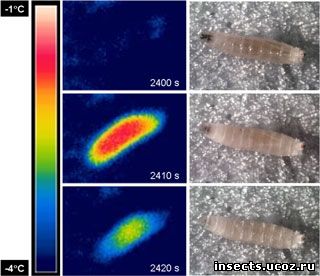| Главная » Статьи » Англоязычные статьи |
 The debate between scientists who study fruit flies and those who work with worms is like the argument between PC and Mac users. Each group is convinced their system is superior. But worm researchers have had one major advantage: worms can be frozen for future study, while fruit flies can’t. But thanks to a new study published this week, worm researchers may lose that bragging right. Scientists in the Czech Republic have developed a technique to freeze fruit flies at subzero temperatures without killing them. "This is the first time that someone has taken something that doesn’t survive freezing and made it freeze tolerant,” said Brent Sinclair, an associate professor of biology at Western University, Canada, in London, Ontario who was not involved in this study. The technique is simple. Vladimir Kostal, an associate professor of biology at the University of South Bohemia, and colleagues fed fruit fly larvae a diet high in proline — a protein known to have cryogenic properties — then exposed the larvae to low temperatures to halt their development. They developed this two-step process by studying Chymomysa costata, a drosophilid fly that tolerates subarctic temperatures and can survive a dip in liquid nitrogen. "We attempted to mimic the two basic tricks that we learned from C. costata and applied them to the fruit fly,” Kostal said. "Surprisingly, this was sufficient to trigger the capacity for survival of ice formation in tropical larvae.” Although Drosophila melanogaster, commonly called the fruit fly, has been an excellent model for genetic and biological studies, its inability to survive freezing has remained a drawback. Meanwhile, scientists who use the worm C. eleganscan develop large lines of mutated specimens to study certain genetic traits immediately or to store for future use. "We have worm envy,” Sinclair said of scientists like him who work with fruit flies. "Worms can be frozen easily which allows scientists to do lots of things we can’t.” For this new study, published online today in the Proceedings of the National Academy of Science (1), scientists spiked regular fly food with increased levels of proline, which is transported from the insect gut to the blood and tissues. Then the group wrapped the larvae inside a piece of wet cellulose, adding a small ice crystal to freeze the larvae’s body fluids. The frozen flies were stored at -5ºC for 75 minutes. After thawing, the scientists provided the larvae with a standard diet and monitored their development. Although most flies died before maturity, nearly 10% developed into normal adults and went on to produce offspring. Although this is an impressive feat, the research has a long way to go before fruit fly researchers can start shopping for freezers. To reduce the risk of molecular damage and decomposition, flies must be stored at temperatures lower than -80ºC. Ideally, they should be able to survive freezing with liquid nitrogen. To get to that point, scientists need to figure out why the larvae survived in their study to begin with. What exactly are proline’s cryogenic properties and how is it different from substances found in other freeze-tolerant organisms? "Our current belief is that adaptation to cold is complex, involving all levels of biological organization, and different cryoprotective substances are used by different organisms,” Kostal noted. "The practical goal is to reach as long as possible storage time, irrespective of temperature, not only in the fruit fly, but in any biological material,” Kostal says. biotechniques.com
| |||||||||||||||||||
| Англоязычные статьи | Добавил: KOLLEKCIONER (09.03.2012) | Просмотров: 1156 | |||||||||||||||||||
Читайте так же:
| |||||||||||||||||||
| Насекомые [65] |
| О насекомых [72] |
| Из личного опыта [3] |
| Содержание насекомых [10] |
| Уничтожение насекомых [8] |
| Тропические бабочки [54] |
| Англоязычные статьи [3] |
| Охота на насекомых [26] |
| Другое [7] |
 Design by KOLLEKCIONER © 2010-2025Хостинг от uCoz
Design by KOLLEKCIONER © 2010-2025Хостинг от uCoz